On the Waterfront: The Architecture Reshaping the Face of the East River
From FiDi and Dumbo to Greenpoint and Murray Hill, new riverfront projects are taking a variety of sizes and forms
By Rey Mashayekhi November 9, 2017 10:15 am
reprints
Last month, Douglaston Development threw a lavish grand-opening bash at Level, its new 40-story, 554-unit rental tower on North 6th Street on the Williamsburg waterfront. As they sipped drinks served by statuesque models in outfits bedecked with flowers, the couple hundred people in attendance enjoyed panoramic views of the Manhattan skyline from the building’s ninth-floor outdoor patio. Just to the south, towering over Level’s patio, stood the Edge and 1 North 4th—the other two Williamsburg residential towers that Douglaston has built and completed just steps from the East River.
With their gleaming glass facades rising hundreds of feet above the river, the Douglaston projects are an embodiment not only of Williamsburg’s transformation into a destination for high-end living, but of how New York City developers are more than ever recognizing the potential of building on the East River waterfront. From the redevelopment of South Street Seaport and the new projects lining Brooklyn Bridge Park near Dumbo, to the massive residential buildings rising in northern Brooklyn and Long Island City, real estate investors are—to an unprecedented extent—capitalizing on the demand for apartments and offices near one of New York City’s main marine arteries.
Of course, this influx of real estate projects along the East River hasn’t happened overnight; it’s been years in the making with policy changes, like the major rezoning of Williamsburg and Greenpoint in the last decade, facilitating the transformation of those neighborhoods’ formerly industrial waterfronts.
But as developers are now springing at the chance to cash in on the rapidly evolving communities on both sides of the water, the East River has become a hotbed for architectural statements that, for better or worse, take many shapes and forms—whether it’s monolithic glass behemoths or metal-clad structures that play with angles and space in different ways.
“It’s hard to generalize about [the buildings], except to say that they’re all intended to take advantage of the riverfront,” said Paul Goldberger, the Pulitzer Prize-winning architecture critic and writer. “What we’re seeing is development that had begun in bits and pieces but is now happening more intensely. Now, it’s as if every last piece of the waterfront is seen as a potential high-end parcel.”
Goldberger noted that “there’s a huge variation in the architectural quality and the type of building” going up along the East River—a claim echoed by Justin Davidson, a fellow Pulitzer winner and architecture critic for New York magazine. “I wish, looking back, that New York had faced this issue with a more holistic sense of what kind of architecture it wanted to foster on the [East River] waterfront,” Davidson said.
What we have, instead, is a disparate and varied array of new projects that are reshaping the riverscape, and the city’s skyline, as we speak. While there are dozens of projects in the works and in various stages of planning or construction, here is a look at some of the more interesting buildings currently being built, in the order one would see them riding up the East River ferry from New York Harbor.
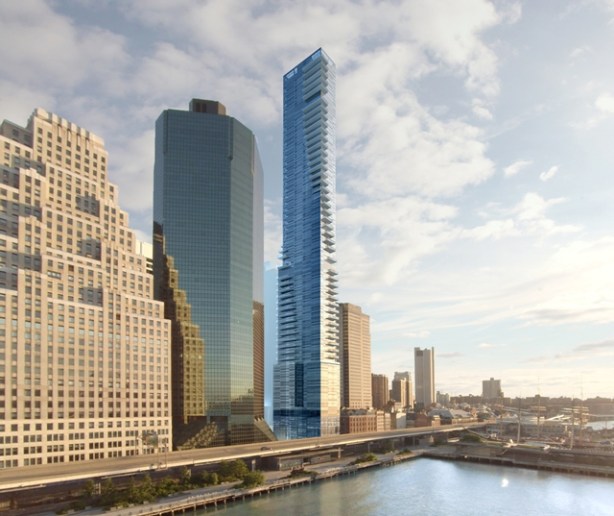
1 Seaport at 161 Maiden Lane
Financial District, Manhattan
Developer: Fortis Property Group
Architect: Hill West Architects
At 161 Maiden Lane, Fortis Property Group is looking to capitalize on the Financial District’s emergence as a residential destination via 1 Seaport—not to be confused with the Jack Resnick & Sons-owned office building at 199 Water Street, which goes by One Seaport Plaza (the two sides settled a court dispute in 2015 over the “1 Seaport” moniker with Fortis agreeing to abandon the name after a designated marketing period).
The design by Hill West Architects deploys that most talked-about trend in New York City architecture over the past decade: the “skinny tower” popularized by the likes of 432 Park Avenue and One57. On completion, 1 Seaport is expected to stand 60 stories and 670 feet tall but will hold only 98 condo units; Jonathan Landau, Fortis’ chief executive officer, said that configuration was dictated in part by the lot’s narrow dimensions.
“There wasn’t really the option to make a wider building,” Landau said. But it was also a situation that “forced us to build a design that enabled us to capture all those great views,” he added—with Fortis and Hill West drawing up floor-to-ceiling “window walls” on the three sides of the tower facing out away from Manhattan.
In September, construction worker Juan Chonilla fell 29 stories to his death at the 1 Seaport site, leading the city’s Department of Buildings to halt work on the project. As of this writing, work at 161 Maiden Lane has ground to a standstill. The building’s concrete skeleton stands around 30 stories above the ground, and its glass facade has already begun to creep up the structure. It’s unclear, however, when work will resume.
“We’re hoping to still complete in time,” Landau said, citing the development’s “mid-2018” targeted completion date. “Unfortunately, there are tragedies like this on a site, and the Department of Buildings has to make sure all precautions are in place. But we’re certain we’ll be back up and running shortly.”
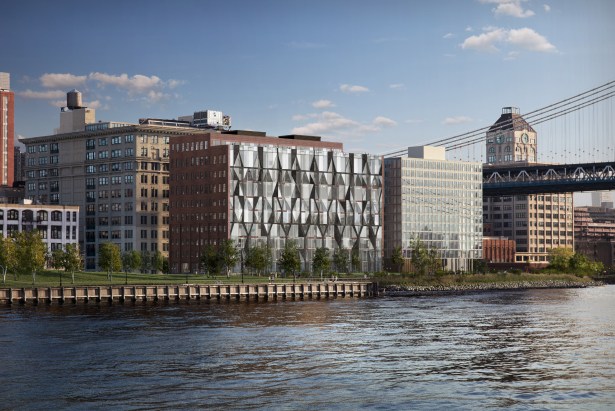
10 Jay Street
Dumbo, Brooklyn
Developer: Triangle Assets, Glacier Global Partners
Architect: ODA New York
After flirting with a residential conversion of its historic 19th century warehouse, nestled just north of the Manhattan Bridge on the Dumbo waterfront, Triangle Assets and Glacier Global Partners looked to the underserved Brooklyn commercial office market in their repositioning of 10 Jay Street.
To helm the project, Triangle and Glacier tapped ODA New York, the Eran Chen-led architecture firm that is currently handling several projects along the East River (more on that later). “We found that ODA had a very unique vision for the building—a very outside-the-box type of architectural thinking,” said Benjamin Stavrach, Triangle’s director of leasing and property management. “We felt that, with the history of 10 Jay being so full of character, they were the proper architect for the project.”
Indeed, ODA harkened to the former industrial building’s history as a sugar refinery in designing the redeveloped eight-story, 230,000-square-foot structure’s most distinct feature: its glimmering, prism-like glass facade, which recalls the shape of crystallized sugar. That river-facing glass curtain wall and the preservation of features, like the original brick columns and the existing brick exterior on the building’s three other sides, were key factors in the project’s approval by the city’s Landmarks Preservation Commission.
“We’re very proud of this [project],” Chen said of 10 Jay Street. “It’s one of those examples where, in collaboration with [LPC], we agreed that the historical narrative of the building has as much importance as the brick and mortar. It would be a building that would clearly separate between what’s historic and what’s the new addition and tell a story about what was there before.”
Despite some construction setbacks caused by dilapidated brick, the building’s envelope is expected to be 100 percent complete by January with a temporary certificate of occupancy targeted for early spring. Stavrach noted that the building is already 35 percent leased (to companies like advertising agency Translation and software firm Nuxeo) despite having yet to hit the market—with tenants almost certainly drawn to 10 Jay Street’s floor-to-ceiling views of the Lower Manhattan skyline, Manhattan Bridge and East River.
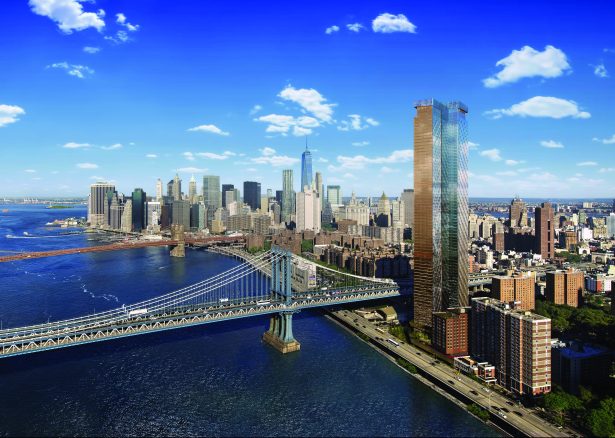
One Manhattan Square
Lower East Side, Manhattan
Developer: Extell Development Company
Architect: Adamson Associates Architects
Looming over the Manhattan Bridge, in the Lower East Side enclave known as Two Bridges, stands Extell Development Company’s One Manhattan Square—the city’s largest new residential condominium development, featuring 815 for-sale units. The 80-story, 800-foot-tall building, which topped out in September, now dwarfs the century-old steel suspension bridge—a fact that does not sit well with many architecturally-minded observers.
Goldberger described the Adamson Associates Architects-designed structure as “a gargantuan, shiny glass tower that is not that different from a lot of what’s gone up in Long Island City and the West Side of Manhattan.”
Davidson, meanwhile, pointed to the “shock” of a building that makes one of the city’s “great monumental pieces of infrastructure look puny in comparison.” He described Extell’s decision to “put up a big hunk of glass” along the river in a remote part of the Lower East Side as “incredibly wasteful.”
But for the Gary Barnett-led development firm, the motivation seems clear. “Gary and Extell are always seeking opportunities to bring value to buyers,” said Raizy Haas, Extell’s senior vice president of development. “There’s very little supply and a lot of demand for waterfront properties.”
Haas offered a defense of both the project and its architecture, noting that “the initial concept was to embrace what we have, which is the water, the sky and the views.” She pointed to 45,000 square feet of outdoor gardens, designed by landscape architecture firm West 8, which wrap up to the building’s fifth floor, as well as the “earthy tone” of the materials used for the project’s podium and the dual, copper-and-silver-toned glass incorporated on alternating sides of the facade.
The building also deploys a “Z-shape” situated at an angle, designed to maximize sightlines and natural light for the tower’s future residents, as well as allow more corner units. “There’s no apartment with bad views,” Haas said. “They all have great views; the question is how great.” Residents will likely begin enjoying those views by the fourth quarter of 2018, when Extell expects move-ins to start, Haas said.
“I think the best thing you can say about it,” Goldberger said of One Manhattan Square, “is that it will be nicer to be in it, looking out.”
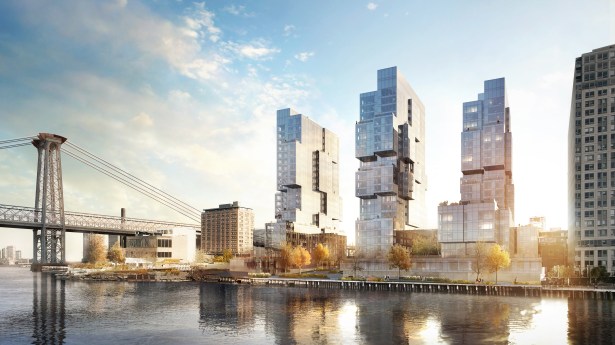
420 Kent Avenue
Williamsburg, Brooklyn
Developer: Spitzer Enterprises
Architect: ODA New York
When Eran Chen and his architecture firm, ODA New York, were handed the responsibility of designing Spitzer Enterprises’ sprawling, three-towered, 857-unit residential complex just south of the Williamsburg Bridge, Chen knew that he wanted to do something different with the assignment.
“When Eliot [Spitzer, the head of the company,] and I met, it was clear that there is something about the building along the front of the East River that is very generic right now,” Chen told Commercial Observer earlier this year. “But the potential of living right on the East River and the openness of the views that you get are insane.”
The solution, as Chen elaborated to CO more recently, was an example of “how real estate value formulas can translate into a beautiful, fresh, new aesthetic.” Rather than simply laying out the buildings in a standard floor plan featuring only four corner apartments per floor, “We asked ourselves, ‘Can we create a tower where every apartment is a corner unit?’ ” Chen recalled. “The answer was yes.”
The shifting, block-like shapes that are 420 Kent Avenue’s defining feature are already taking form at the development site, which Chen said is moving along “exactly as planned.” The northernmost tower’s superstructure was completed several months ago and is already wrapped in its glimmering, glass curtain wall with completion slated for the late spring or early summer of next year. The other two towers, bound by a shared podium structure, are following suit and should be done by early 2019.
As well as bringing added real estate value to the project—as Chen noted, corner units command higher rents—the design allows 420 Kent to “break the mold of the box shape” that has characterized many of the projects along the East River to date, Chen said.
“ODA really understands New York,” Davidson said of Chen’s firm. “They take all of these zoning constraints that make a lot of other architects throw their hands up and do whatever the constraints allow and really try to figure out what the zoning is looking to achieve and work within that. I think if everybody took that approach, we’d have a much nicer city.”
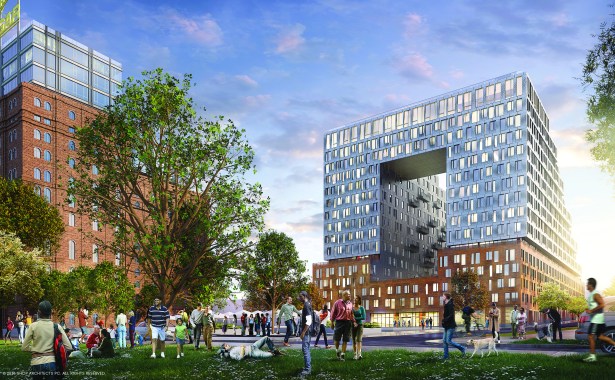
325 Kent Avenue
Williamsburg, Brooklyn
Developer: Two Trees Management
Architect: SHoP Architects
After years of planning, Two Trees Management’s massively ambitious redevelopment of the former Domino Sugar Refinery is finally taking shape—most notably through 325 Kent Avenue, the 16-story rental building comprising the first piece of the developer’s plans for a sprawling mixed-use complex just north of the Williamsburg Bridge.
The 505-unit property is the smallest building on the site, according to Two Trees Managing Director David Lombino, which gives one an idea of how big, exactly, the Domino Sugar redevelopment will be. Yet it is the SHoP Architects-helmed design, which features a prominent aperture (i.e., enormous hole) in the river-facing facade and clads the building in copper and zinc, which is the most impressive indicator of where Two Trees intends to go with the project at large.
Lombino said that Two Trees charged SHoP with a mission to reject the type of “very mundane, glass residential buildings topping out at 40 stories” along the waterfront—“buildings that had very little to do with the neighborhoods they were in and had their backs to them, in many cases.”
By design, Kent Avenue is “built to the same scale” as the landmarked brick refinery building next to it, according to Lombino. Moving away from the waterfront, the building “slopes down to the neighborhood as an attempt to meet scale”—going from 16 stories to five by the time it reaches Wythe Avenue.
As for that aperture, “it lets light and air pass between the waterfront and the neighborhood behind it,” he said. “You can see Manhattan from Wythe Avenue and from Berry Street and Bedford Avenue” further inland. It also functions as “a clever way to bring natural light to our tenants” and is an architectural flourish that Two Trees is using at all of the new buildings on the site, Lombino added. “That was a statement about the wall of glass development that’s happening [in Brooklyn] and our desire to treat both sides of the river with equal respect.”
The building is nearing completion and has already started leasing on a rolling basis with part of the property opening this past summer and all construction slated for completion by the end of this year. Meanwhile, Two Trees is already pouring the foundation at 260 Kent Avenue—the 40-story, COOKFOX-designed mixed-use tower that will be the next piece of the Domino Sugar puzzle.
“I think this is an example of an area where the developer is thinking about all of the pieces as they relate to the whole,” said Davidson, who noted that Two Trees has worked extensively with the Department of City Planning and the LPC in designing the project and getting it approved. “There is some civic and urban thinking going into this project, which makes it different from most others.”
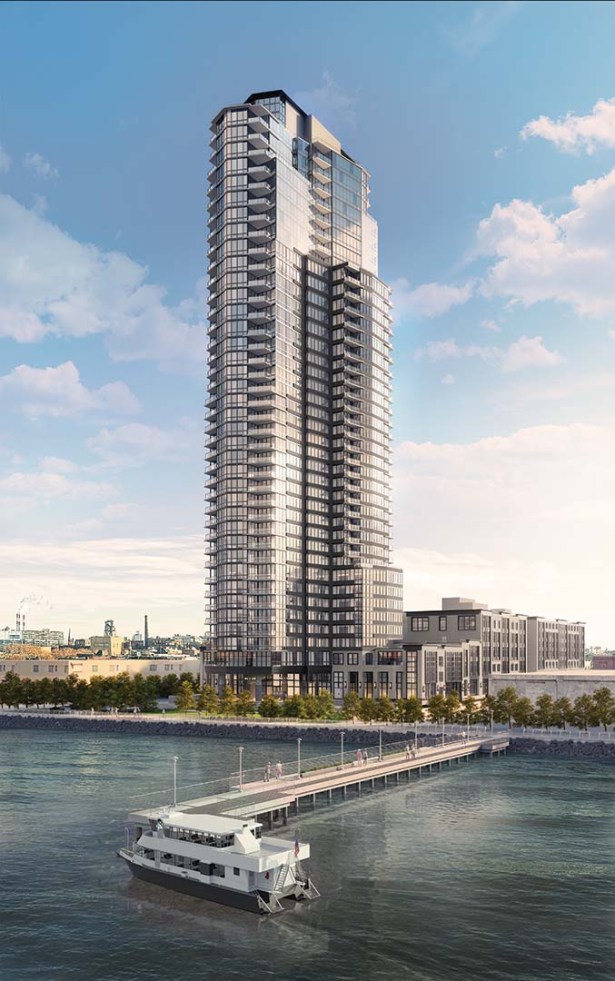
The Greenpoint
Greenpoint, Brooklyn
Developer: Mack Real Estate Group, Palin Enterprises, Urban Development Partners
Architect: Ismael Leyva Architects
Greenpoint is witnessing its fair share of transformation these days, but nothing compares to the 39-story, 605-unit residential tower at 21 India Street that bears the neighborhood’s name. The 400-foot-tall structure, currently being built just steps from the banks of the East River, promises to change the game entirely.
Mack Real Estate Group came into the project “a little late,” according to Richard Mack, the company’s co-founder and CEO. He recalled how original plans by Palin Enterprises and Ismael Leyva Architects—while “very beautiful as conceived”—didn’t address market trends that have seen increased demand for “smaller rentals and larger condos.” So Mack and his director of development, Gary Davis, redesigned the 95 condo units at the top of the tower to be larger, while scaling down the rentals at the tower’s base. “We thought it would be more economical for renters and more spacious for buyers,” Mack said.
While most would be hard-pressed to argue that The Greenpoint fits within the existing context of the neighborhood given its sheer scale and imposing glass facade, Mack and Davis both contend that they tried to make the building “more contextual” by paying homage to the area’s industrial past. So they altered the color of the glass and introduced brick and steel elements—“Like you would see in a Tribeca or Soho warehouse,” Mack said—to the building’s podium.
“We said, ‘Let’s make it feel industrial and give you the sense that you are in an industrial building,’ ” Mack added.
Davis noted that “there are going to be lots of towers along the [Greenpoint] waterfront in the coming years,” and given the plans currently being drawn up by developers for nearby parcels—as well as the 10-building Greenpoint Landing residential complex also under construction up the street—it appears that the area’s waterfront is slated to experience a building boom similar to Williamsburg’s just south.
“It is a harbinger of other things to come,” said Goldberger. “We’re basically using every piece of waterfront we can find.” He noted that, while many builders attempt to tip their cap to the neighborhoods they are transforming, oftentimes such efforts merely paper over sizable changes to the aesthetic fabric of the community.
“I think it does what a lot of buildings have done, which is make a few minor gestures to the neighborhood that are maybe even disingenuous,” Goldberger said of The Greenpoint. “They’re trying to have it both ways.”
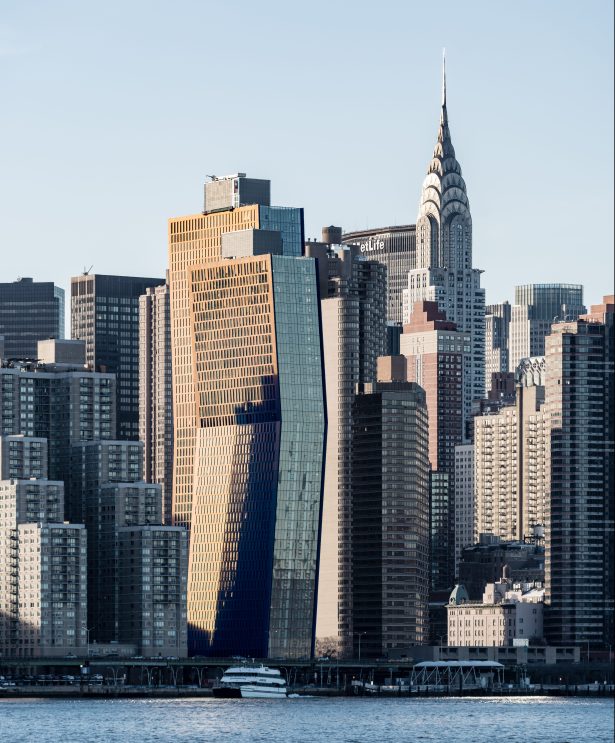
American Copper Buildings
Murray Hill, Manhattan
Developer: JDS Development Group
Architect: SHoP Architects
With projects like 111 West 57th Street on Billionaires’ Row in Midtown and 9 DeKalb Avenue in Downtown Brooklyn currently in the works, JDS Development Group has justifiably earned a reputation for pursuing the kind of supertall, luxury residential developments that make a point of redrawing the New York City skyline.
But for the American Copper Buildings at 626 First Avenue between East 35th and East 36th Streets in Manhattan, JDS head Michael Stern had to take a different approach—thanks to zoning requirements that included a height limit and a mandate that, whatever JDS built there, it would have to touch the ground at specific locations on the site.
“We challenged SHoP [the project’s architect] to come up with something that would be architecturally dynamic but not upset the applecart of the existing zoning,” Stern explained. “With the height limit, there was no way to fit the floor area in one tower. It would have been more efficient to build one tower, but we’re very happy with where we ended up.”
The Murray Hill project winded up taking the form of two copper-clad, angular towers standing 41 and 48 stories each, one set back further from the river than the other, and both bound by a 100-foot-long sky bridge connecting the 27th through 29th floors. The copper exterior that lends the towers their name was proposed by SHoP. “It’s not cheap, but they did a great job engineering and procuring it,” Stern said. “It came out really spectacular.”
Today, the American Copper Buildings are virtually complete with finer touches set for completion by the end of the year. About half of the buildings’ 760 rental units are leased and occupied, Stern said.
“I appreciate that they’re high-rise buildings that are not exclusively glass,” Davidson said. “They’re using a material that has a long New York history and that will change as it ages. Materials like stone, brick, terra cotta and copper, when they’re cladding high-rise buildings, respond to time.”
Goldberger also praised the architecture and described the towers as “quite elegant,” albeit “a little bit of a gimmick.” He noted, however, that “on some level the top of the Chrysler Building is a gimmick as well—but it’s also brought us joy and pleasure for 90 years.”
“There’s nothing wrong with architecture that has the ability to catch your eye as you’re going past it,” Goldberger added. “I do find, whenever I pass it on the FDR Drive, that it holds my attention. Part of good architecture is providing a certain amount of visual entertainment.”


